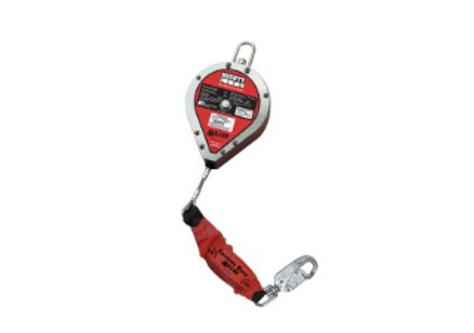How To Inspect Your SRLs To Be In Compliance With ANSI Z359
In addition to new requirements for manufacturers of self-retracting lifelines when meeting updated ANSI Z35914 regulations, companies using the SRLs have work to do if they want to stay compliant with the American National Standards Institute's voluntary consensus standards. In creating this new standard, ANSI is trying to create a culture of SRL and fall protection inspection and certification across industries involved in at height work. It's now up to end users to inspect and maintain their equipment if they want to stay compliant.
On-site inspection of a company's SRLs needs to be completed by a competent person. ANSI and OSHA both define a competent person as someone who is capable of identifying existing and predictable dangerous conditions, and who has the authority to take corrective actions. This person is designated by the employer to be responsible for the immediate supervision, implementation, and monitoring of the employer's managed fall protection program.
If it sounds like a lot of work and responsibility, you're right. The person in this position has a very serious responsibility to both the company and the workers.
One of the new requirements for the manufacturers is to include some kind of visual signal to show potential users or a competent inspection person when an SRL has been involved in a serious fall. Typically SRLs with wire lifelines will have a red band around a portion of the self-closing snap hook that is revealed in the event of strain from preventing a fall. SRLs with nylon webbing lifelines have tear-away sections that show exposed red stitching after a fall. This is the first step in the SRL inspection.
To perform an SRL inspection, it's a good idea to wear gloves. Metal barbs on the cable lifelines can be particularly nasty, and sooner or later you're going to come across one.
After a visual inspection looking for impact tell-tales at the end of the lifeline, it's time to check the snap hooks are functioning properly. They must close fully and when released. The carabiner on top of the device which connects to the anchor point must also be self-closing and self-locking, and close fully.
Next take a careful look at the housing. Make sure no cracks in the housing are visible, and check for missing or loose screws holding the housing and hardware together.
Labels on the housing must be legible. Model number, serial number, and date of manufacture must all be easily read, as well as the user capacity and other specifications unique to the SRL. Inspection records are also on the retractable's housing. It's important that records of these regular inspections are marked down and easy to read during the next inspection.
To make sure everything on the inside of the unit is functioning well, you'll next need to withdraw the entire length of the cable from the unit. As you pull out the cable, make sure there are no cuts, burrs, or kinks in the line. With webbing lifelines make sure there are no burn holes or cuts along the length. Also look for dirt, grime, or residue that may impede the unit from retracting the lifeline completely. If the lifeline doesn't retract fully, or if it sticks in certain places, it's a sign that the internal spring may not be functioning properly.
If any of these tests fail, the unit needs to be removed from service, and sent in for servicing.
Another test your SRL will need to pass is the brake check. Give the lifeline a quick tug and make sure the braking mechanism engages. With cable lifelines remove the rubber bumper and check the connection to the snap hook. Look to make sure the cable crimps are all in place and there is no rust or abrasion where the boot covers.
If you have any questions about ANSI requirements or SRL inspections, please submit your question here or give us a call at 1-800-829-9580.
Recent Posts
-
Promoting Safety: National Work Zone Awareness Week is April 15-19, 2024
Each year, the National Work Zone Awareness Week (NWZAW) places the spotlight on the importance o …Apr 11th 2024 -
Understanding 4 Gas Monitors: How They Work & Why They Are Important
In today’s increasingly dynamic industrial landscape, 4 gas monitors have emerged as critical com …Apr 8th 2024 -
April Showers Require Workers to Wear Hi-Vis Safety Rain Gear
While April showers bring May flowers, they also bring challenges, particularly for those working …Apr 1st 2024





